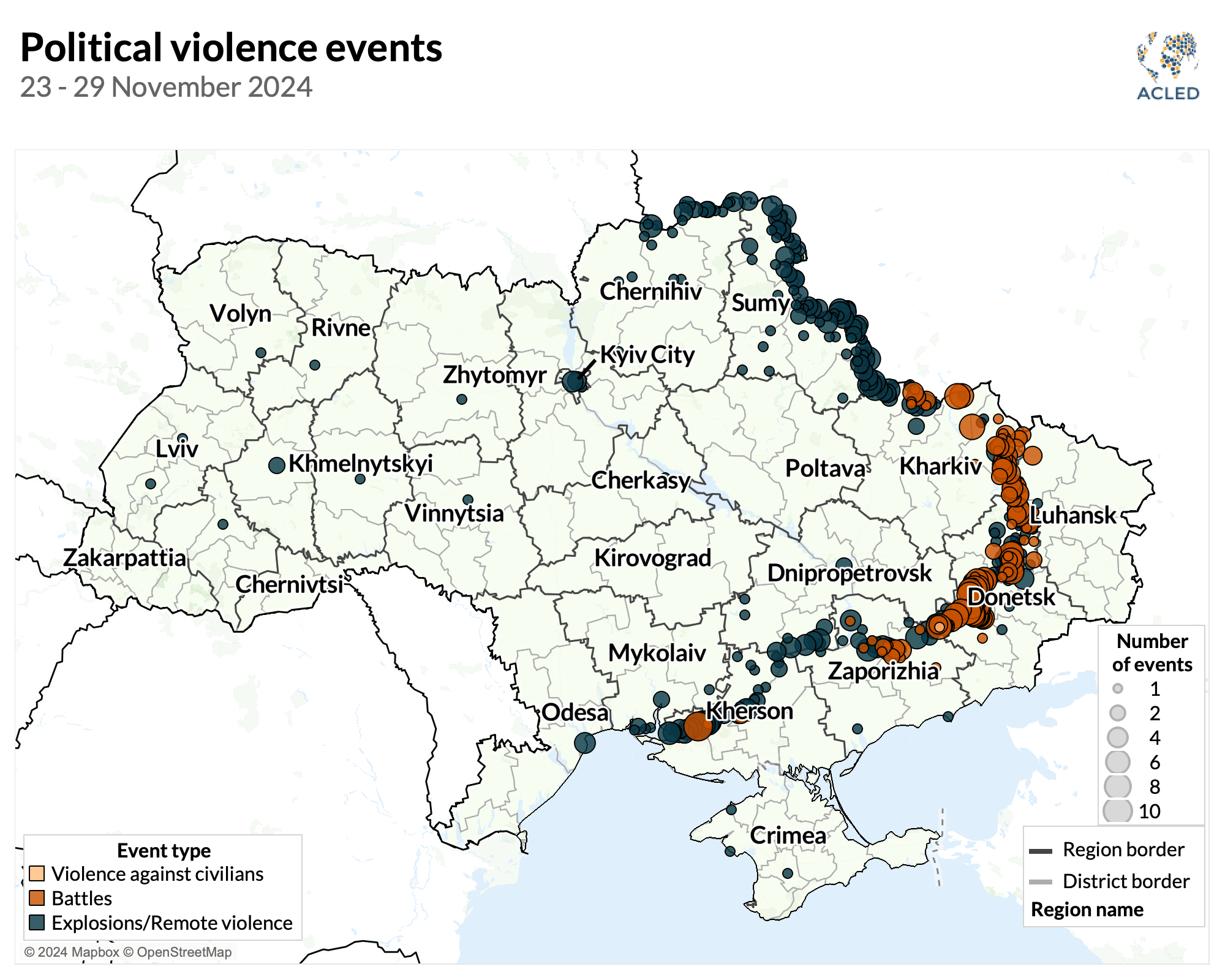Key trends
- In the Donetsk region, Russian forces occupied four settlements south of the key city of Pokrovsk. Russian forces also occupied a settlement northeast of the town of Velyka Novosilka.
- In the Kharkiv region, Ukrainian forces pushed Russian forces from the suburbs of Kupiansk. Russian forces continued to advance along the Kharkiv-Luhansk administrative line, seizing one village.
- ACLED records 34 Russian long-range missile and drone strikes, including in the western regions of Lviv, Volyn, Ternopil, and Vinnytsia. Ukrainian forces also intercepted strikes in at least 38 further instances.
- Russian shelling, missiles, and drones killed at least 19 civilians across Ukraine, almost half of them in the Kherson region.
Key events
- 24 Nov. | Zaporizhia – Russian forces execute five Ukrainian prisoners of war near Novodarivka
- 25 Nov. | Mykolaiv – A Russian FPV-drone strikes a humanitarian aid distribution site in Solonchaky, killing a civilian
- 26 Nov. | Kherson – Russian shelling of a bus stop kills four civilians in occupied Nova Kakhovka
Spotlight: Russian strikes on energy infrastructure disrupt electricity grid and nuclear power plants
Russian forces continued to deliberately target energy infrastructure across Ukraine, triggering massive power cuts and disconnecting nuclear power plants from the grid. On 26 and 28 November, Russian airstrikes hit energy infrastructure in western and central regions of Ukraine, disrupting power supply to most households and facilities in Ternopil, as well as Lviv, Volyn, Khmelnytskyi, Ivano-Frankivsk, and Zhytomyr regions.1Hanna Arhirova and Barry Hatton, ‘Latest ‘massive’ Russian aerial attack cuts power to 1 million homes in Ukraine’, AP, 28 November 2024 Despite the interception of most drones and missiles, the Ukrainian military and civilian authorities acknowledged the range and deep impact of the attacks on the energy sector,2Radio Free Europe / Radio Liberty, ‘Massive air attack: what Russia attacked on 28 November and where it hit’, 28 November 2024 as the national grid operator was forced to introduce emergency power outages, including some of up to 12 hours.3Anastasiia Malenko, Olena Harmash, Max Hunder, ‘Russia hits Ukrainian energy facilities, Kyiv sees ‘despicable escalation’’, Reuters, 28 November 2024 In addition, Russian forces continued to target energy workers during the week, as exemplified by the 26 November drone strike against energy workers during repair works in the Dnipropetrovsk region.
In light of the forced outages and repeated strikes, the International Atomic Energy Agency (IAEA) reiterated its warning about the danger posed to global nuclear safety by the attacks on substations and power lines near Ukrainian nuclear power plants, which need reliable connections to both distribute electricity and cool their reactors.4IAEA, ‘Update 262 – IAEA Director General Statement on Situation in Ukraine’, IAEA, 28 November 2024 The warning follows several appeals from the UN Secretary General and the OHCHR to the Russian Federation to cease attacks against all energy infrastructure in Ukraine, especially nuclear sites and energy workers.5United Nations, ‘UN chief condemns Russian strikes on Ukraine’s energy system’, 17 November 2024; UN News, ‘Russian strikes on Ukraine’s energy system risks nuclear disaster: Rights experts’, 25 November 2024; OHCHR, ‘Plight of civilians as result of attacks on energy network’, 29 November 2024 The country faces an already acute energy crisis, as the Russian strikes have halved Ukraine’s energy production capacity and fractured the distribution network.6Olena Harmash, ‘Ukrainians find new energy sources to beat blackouts as winter arrives’, Reuters, 3 December 2024
Explore the ACLED Conflict Exposure tool to assess the numbers of people affected by armed violence, disaggregated by locations, time period, and actors involved.





